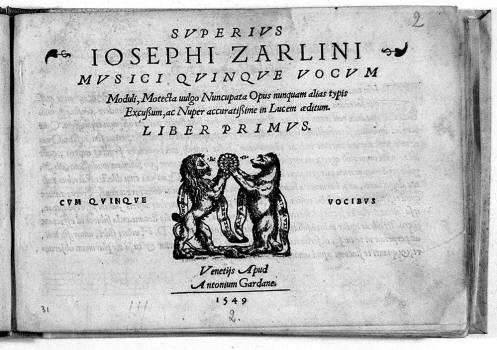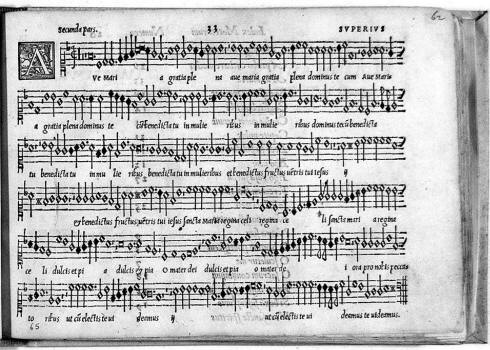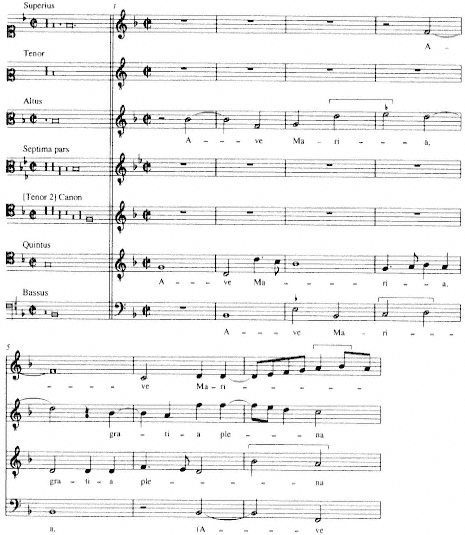Zarlino, Gioseffo - Ave Maria
 for 7vv. a cappella
for 7vv. a cappella
 | Composer: Gioseffo Zarlino (1517-1590) Aliases, aka: Country of origin / activity: Italy | |
| Text author: traditional | ||
| Arranger / Editor: N/A |
Available documentation:
Score:| facsimiles of 1549 edition http://www.examenapium.it/zarlino/1549.htm | |
 |  |
| Modern notation: not available | |
 Zarlino, Pater noster (secunda pars): Ave Maria, mm. 1-7; Musici moduli liber primus (Venice, 1549), p. 33. | |
| My thanks and appreciation to ... for sending me this score. | |
Lyrics: (source)
| not available |
| MIDI: not available |
| Recording: | MP3: |
 | Play / stop MP3 CD: Gioseffo Zarlino: Canticum Canticorum Salomonis tr12: pater noster - Ave Maria 11:13 |
Video - posted on YouTube:
| not available at this time | YOU could be featured here! If you or your choir perform this Ave Maria, make a video recording. Post your video on YouTube, email me the page URL and I'll embed the video in this page. |
Internet references, biography information:
| http://en.wikipedia.org/wiki/Gioseffo_Zarlino |
From Wikipedia, the free encyclopedia Life In 1565, on the resignation of Cipriano de Rore, Zarlino took over the post of maestro di cappella of St. Mark's, one of the most prestigious musical positions in Italy, and held it until his death. While maestro di cappella he taught some of the principal figures of the Venetian school of composers, including Claudio Merulo, Girolamo Diruta, and Giovanni Croce, as well as Vincenzo Galilei, the father of the astronomer, and the famous reactionary polemicist Giovanni Artusi. Works and influence Zarlino was the first to recognize the primacy of the triad over the interval as a means of harmonic thinking. His development of just intonation came from a realization of the imperfection of the intervals in the Pythagorean system, and a desire to retain as much purity as possible using a limited number of tones. See: Ptolemy's intense diatonic scale. He was also the first to attempt an explanation of the old prohibition of parallel fifths and octaves as a rule of counterpoint, and the first to study the effect and harmonic implications of the false relation. Zarlino's writings, primarily published by Francesco Franceschi, spread throughout Europe at the end of the 16th century. Translations and annotated versions were common in France, Germany, as well as in the Netherlands among the students of Sweelinck, thus influencing the next generation of musicians who represented the early Baroque style. Zarlino's compositions are more conservative in idiom than those of many of his contemporaries. His madrigals avoid the homophonic textures commonly used by other composers, remaining polyphonic throughout, in the manner of his motets. His works were published between 1549 and 1567, and include 41 motets, mostly for five and six voices, and 13 secular works, mostly madrigals, for four and five voices. His 10 motets on the Song of Songs used the text of Isidoro Chiari's translation of the Bible. |
http://www.britannica.com/EBchecked/topic/655982/Gioseffo-Zarlino |
Zarlino took deacon’s orders in 1541 and studied music under Adriaan Willaert at St. Mark’s in Venice, where in 1565 he became music director. Although he was esteemed as a composer, few of his works survive. He was offered the bishopric of Chioggia in 1583, but the Venetian senate persuaded him to remain in Venice. Zarlino’s first treatise, Istitutioni harmoniche (1558), brought him rapid fame. It gives a shrewd account of musical thinking during the first half of the 16th century, and Zarlino’s thoughts on tuning, chords, and modes anticipate 17th- and 18th-century developments. He discussed the tuning of the first four intervals of the scale (tetrachord), espousing a system that proved reliable in subsequent practice. He stressed the importance of the major and minor third and discussed the nature of the major and minor triads, anticipating the theories of later writers such as Jean-Philippe Rameau. He renumbered the medieval modes, placing the Ionian mode (corresponding to the modern major scale) first. He also gave one of the two earliest accounts of double counterpoint and offered detailed advice on the setting of words to music. His Dimostrationi harmoniche (1571) consists of five dialogues between Willaert and four friends; it amplifies much of the material he had set forth in the Istitutioni. Zarlino’s theories were violently attacked by Vincenzo Galilei, his former pupil and a member of the Florentine Camerata, a group influential in the evolution of opera. Zarlino replied with Sopplimenti musicali (1588) and collected his works into a complete edition in 1589. The Sopplimenti reinforces and develops his previous theories. One passage suggests equally tempered tuning for the lute (in advance of 18th-century experiments with equal temperament on keyboard instruments); another gives valuable descriptions of early organs. Zarlino strongly decried the monodic recitative of the Camerata, insisting that music has its own laws and should not abandon them in order to imitate the spoken word. |
http://mtosmt.org/issues/mto.13.19.3/mto.13.19.3.judd.php |
| “To Discourse Learnedly” and “Compose Beautifully”: Thoughts on Gioseffo Zarlino, Theory, and Practice Cristle Collins Judd |
 avemariasongs
avemariasongs org
org